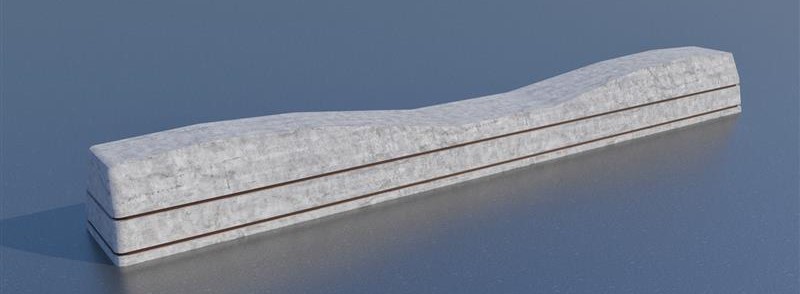
FLEXSTREN
FLEXSTREN introduces a new way to give flexural strength to concrete products, overcoming steel reinforcing limitations (concrete cover requirements and steel corrosion).
Concrete pipes producer add value to their products with FLEXSTREN
Concrete product manufacturers can produce new cost-effective products, and increase competitiveness versus non-concrete competitors
Wide range of applications in pipe production
Concrete pipes become cost competitive versus plastic, GRP pipes, and traditional RCP pipes:
- They no longer need to be reinforced with steel reinforcing cages, so they are corrosion free.
- The external post tensioned composite wrapping ensures impermeability even for pressure applications (more than 3.5 Bar), and the pipe can also be buried on aggressive soil environments.
- Jacking pipes have a much greater axial capacity.
- The elimination of a minimum depth of covers makes it possible to do pipes with a thickness 1/20 of the diameter. So thin concrete pipes have semi-rigid behavior, with easier soil compaction vs fiber / plastic pipes.
- It becomes possible and cost effective to do concrete pipes with diameter from 200 mm.
This technology will open up new markets such as irrigation, and the pressure part of the sewage applications (concrete pipe producers can now supply also the sections with pressure), along with thermal / hydroelectric plants.
PRODUCTION PROCESS:
NO STEEL REINFORCING CAGE – NORMAL CASTING AND CURING – THEN WRAPPING OF THE PIPES WITH A CONTINUOUS TENSILE COMPOSITE
Casting and curing process remains the same – but no reinforcing cage. Then, after normal curing, the concrete pipe is wrapped according to the FLEXSTREN Technology.
Wrapping fiber roving
FLEXSTREN Technology consists in wrapping an impregnated fiber roving around the product to be reinforced.
- The fiber roving is wrapped in tension along with a thermo setting resin and this generate a compression in the concrete.
- This tensioned wrapping is applied in multiple layers taking advantage of a very uniform stress distribution and a very low resin requirement.
- The number of layers determines the amount of compression given to the concrete.
The generated compression is bi-axial. The process is applicable to many concrete products, even from immediate stripping process where is it very difficult to apply prestressing and where traditional post tensioning is difficult due to geometry, cost, and the intrinsic limited productivity.
While this is a quite revolutionary method, there are ASTM, ACI and ISO specs for appropriate calculations. These basically follow the FRP prestressing and post tensioned reinforcement method.
ABOUT EXISTING USAGE OF CONCRETE AND FRP
Most of the fibers and FRP rebars currently in use as reinforcement for concrete, have a much lower Young’s Modulus vs. steel and in many cases just slighter higher than concrete.
Because of this the concrete cracks with very modest reinforcement stress making FRP very expensive vs. traditional steel reinforcing if the crack size is what is driving the structure sizing. This is typically the norm worldwide.
FRP rebars are produced by pultrusion which is a method that is not very effective on the medium and large rebar sizes, the sizes the market is normally requiring. This low efficiency is not related to production volume but is actually related to the pultruted product specific stress capacity. Basically, the large rebar sections are experiencing up to a 60% drop in the stress capacity.
In case of dispersed fibers, the situation is even worse since most of the fibers are not oriented to the concrete product tensile stress and when the dosage exceeds a relatively small percentage, the concrete becomes difficult to be placed and handled.
As we know, high strength fibers have a cost per Kg that is much higher than steel and magnitude of times higher of any concrete component and admixture.
OUR APPROACH
is basically to use the least amount of fiber as possible. To achieve this we use it in tension, transforming the fiber’s low Young’s Modulus from a disadvantage to an advantage.
Our fiber is 100% oriented in the tensile stress direction and the specific stress capacity of our formed FRP is significantly higher than what is possible to achieve with pultrusion or any other method for produce FRP rebars.
CO2 SAVINGS
FLEXSTREN reduces enormously the CO2 footprint since it impacts various aspects:
- Corrosion free brings a lower CO2 emission because of the longer product life cycle
- Lower material cost provided by a reduction of the thickness.
- Composites have lower CO2 footprint versus steel reinforcement
WRAPPING MACHINE AND COMPOSITE
The wrapping machine wraps in diagonal in order to induce both a radial and longitudinal post compression.The composite material is easily purchased locally, and consists of fiber (can be 2 types: glass or basalt fiber. Basalt fiber is more expensive, and completely unassailable from the chemical point of view) and resin.
Possibilities of IP acquisition and start-up production
Please contact







